Raise your hand if you’ve read a sentence like this before: Digital transformation is now a critical imperative and those who do not embrace it will be left behind.
Of course you have. And if you’re a B2B content marketer, you’ve probably written sentences like it, too. Let’s face it, the message is tired, even though the “digital transformation imperative” has never been more real.
That’s the problem: There’s a disconnect between the actual digital transformations taking place in the enterprise world, and the way marketers talk about them. In a post-pandemic world, your B2B audience’s digital expectations have evolved. Stop writing about digital transformation like it’s 2019. You can start by avoiding these three common mistakes.
Mistake #1: You Repeat What’s Already Been Said
For the past several years, technology pundits have expressed their annoyance that digital transformation is an overused buzzword, made meaningless because it’s used so often and applied to nearly any tech topic. But marketers don’t just repeat the word itself—they echo the same talking points: how digital transformation is accelerating, how it will make or break your business, how it’s a top CEO priority, yada yada. Click “play” on any B2B product video and the odds are good that a deep-voiced narrator will lead with these tired themes.
For B2B tech marketers, digital transformation messaging creates a sense of urgency around adopting their solutions or products. That’s fair game, but too many of the talking points have gone stale from repetition. Use them and your audience will shrug.
The takeaway: Find something fresh and relevant to say about digital transformation (if you must say something).
For inspiration, tap into the firms and publications that track digital transformation trends and produce the most provocative thought leadership: HBR, CIO, Forrester, Deloitte, and others. With fresh source material in hand, you can craft more compelling and interesting editorial angles for your content. And you can more effectively position your company’s solutions around these concepts.
For example, look at this thought leadership article from Crowe, a public accounting firm and consultant (also a Tendo client). It focuses on an important aspect of digital transformation: CEO anxiety and uncertainty, and how to overcome it. The article draws from recent Crowe and Dell survey data and is informed by the Crowe team’s conversations with their customers.

Mistake #2: You Keep It Vague and Abstract
Too many of the narratives about digital transformation glide along at the 30,000-foot level, never diving into substantive detail. Look at the paragraphs below (from a not-to-be-named company), peppered with business jargon and generic statements framed as bold pronouncements. For all the words deployed, it says very little.

This type of abstract prose is not only unconvincing, it’s unforgivable in 2022. Because COVID-19 changed everything, making digital transformation real and tangible like never before. Instead of pontificating about digital transformation, companies had to execute it, and fast. They solved do-or-die problems overnight, shifting business models and reinventing how they connect with customers. The success stories are everywhere.
The takeaway: Get real, get specific. Talk about the problem you’re solving and the business outcomes you’ve achieved—not about digital transformation itself.
Compelling B2B content articulates how a specific solution solves a specific problem, with no marketing fluff or blather. Check out this Salesforce blog post on how and why small businesses are switching to a digital-first business model. In understandable prose, the writer breaks down recent survey results from small-business customers, distills the findings into concise action items, and positions Salesforce’s CRM Starter Pack in the process.

Mistake #3: You Talk Only About Technology
Focusing on technology first is widely regarded as a recipe for digital transformation failure. As this HBR article quips, “companies put the cart before the horse, focusing on a specific technology (‘we need a machine-learning strategy!’) rather than doing the hard work of fitting the change into the overall business strategy first.”
The same can be said for digital transformation content. When shiny technology drives your narrative, there is less room to talk about customer needs, challenges, and experiences. Marketers fail to recognize that digital transformation isn’t just about digital products and platforms: It’s a journey that touches business strategy, internal process, company culture, customer experience, and yes, IT. All those elements should be part of the story.
The takeaway: Frame the digital conversation around customer needs and business outcomes—not technology.
Make your B2B content solution-focused, not product-focused, and customer-focused, not company-focused. That’s one of Tendo’s primary mantras for better B2B messaging.
The Future of Digital … Is Yours to Shape
Digital transformation will continue to be a rich and vital conversation in the years ahead. As a B2B marketer, you’ll play a major role in making that narrative memorable and helpful, with fresh insights, actionable details—and your customers at the heart of the story.









